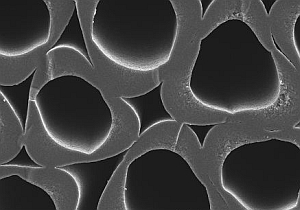Materials scientists at Oak Ridge National Lab in Tennessee have developed a technology for converting polyethylene, the material used in plastic bags, into carbon fibers engineered for specific applications. The findings of Amit Naskar and colleagues from Oak Ridge and University of North Carolina at Chapel Hill appear today online in the journal Advanced Materials (paid subscription required).
Naskar’s team took the polyethylene raw material and produced fiber bundles that they dipped into an acid bath that breaks down to form a black fiber, until it can melt no further. “At this stage, the plastic molecules bond, and with further heating cannot melt or flow,” says Naskar. “It is this sulfonation reaction that transforms the plastic fiber into an infusible form.” The remaining fiber material is almost entirely carbon, with other materials emitted as vapors.
The sulfonation process allows for engineering the properties of the fiber material dictated by the processing conditions. The researchers were able to produce carbon fibers with unique cross-sectional geometries, from hollow circular to gear shapes by using a multi-component melt extrusion-based fiber spinning method.
Adding this spinning method to their sulfonation technique, Naskar and colleagues demonstrated that they can make fibers from polyethylene with varying surface contours and pre-determined filament diameters down to a sub-micron scale (one micron equals one millionth of a meter). The process, for which a patent has been applied, also allows them to tune the porosity of the fibers, making the material potentially useful for filtration, catalysis, and electrochemical energy harvesting.
The raw polyethylene material for these engineered fibers, which is abundant and inexpensive, could come from discarded grocery store plastic bags, carpet backing scraps and salvage. The Oak Ridge Lab says the finished products could be used in strong, lightweight manufactured goods such as automotive parts that can help cars achieve improved gas mileage without compromising safety and comfort.
Read more: Process Devised for Custom-Made Composite Materials
* * *


 RSS - Posts
RSS - Posts
This shop specializes in all kinds of motor beauty products that have a carbon fiber label, stick, paint pen for cars and other supplies. Welcome to our web browsing, maybe you fall in love with products. This shop can be wholesale, welcome large orders. Thank you.
[…] Process Developed to Convert Polyethylene into Carbon Fiber […]